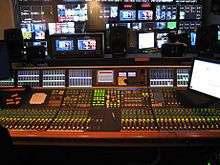Audio mixing
Audio mixing is the process by which multiple sounds are combined into one or more channels. In the process, a source's volume level, frequency content, dynamics, and panoramic position are manipulated and or enhanced. Also, effects such as reverberation and echo may be added. This practical, aesthetic, or otherwise creative treatment is done in order to produce a finished version that is appealing to listeners.
Audio mixing is practiced for music, film, television and live sound. The process is generally carried out by a mixing engineer operating a mixing console or digital audio workstation.
Recorded music

Before the introduction of multitrack recording, all the sounds and effects that were to be part of a recording were mixed together at one time during a live performance. If the sound blend was not satisfactory, or if one musician made a mistake, the selection had to be performed over until the desired balance and performance was obtained. However, with the introduction of multitrack recording, the production phase of a modern recording has radically changed into one that generally involves three stages: recording, overdubbing, and mixdown.[1]
Film and television

Audio mixing for film and television is a process during the post-production stage of a moving image program by which a multitude of recorded sounds are combined. In the process, the source's signal level, frequency content, dynamics and panoramic position are commonly manipulated and effects added.
The process takes place on a mix stage, typically in a studio or theater, once the picture elements are edited into a final version. Normally the engineer will mix four main audio elements: speech (dialogue, ADR, voice-overs, etc.), ambience (or atmosphere), sound effects, and music.
Live sound

Live sound mixing is the process of electrically blending together multiple sound sources at a live event using a mixing console. Sounds used include those from instruments, voices, and pre-recorded material. Individual sources may be equalised and routed to effect processors to ultimately be amplified and reproduced via loudspeakers.[2] The live sound engineer balances the various audio sources in a way that best suits the needs of the event.[3]
References
- ↑ Huber, David Miles (2001). Modern Recording Techniques. Focal Press. p. 321. ISBN 0240804562.
- ↑ "Mixing Principles". Leonard Audio Institute. Retrieved 2013-01-03.
- ↑ Tim Crosby. "How Live Sound Engineering Works". HowStuffWorks. Retrieved 2013-03-03.
Further Reading
- Rose, Jay, Producing Great Sound for Film and Video. Focal Press, fourth edition 2014 Book info. ISBN 9780415722070